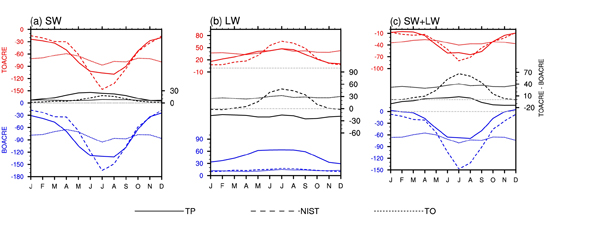State Key Laboratory of Numerical Modeling for Atmospheric Sciences and
Geophysical Fluid Dynamics (LASG)
Institute of Atmospheric Physics, Chinese Academy of Sciences

Vol. 1/No.1 December 2016
Cloud, Precipitation, Radiation and Large-scale Circulation over the Tibetan Plateau
Cloud plays an important role in the energy cycle and balance of the Earth's climate system. Recently, Dr. YAN Yafei, Prof. LIU Yimin and Prof. LU Jianhua have analyzed the vertical structure of clouds, its connection with precipitation and cloud radiative effects (CRE) over the TP based on CloudSat and Cloud-Aerosol Lidar and Infrared Pathfinder Satellite Observations (CALIPSO) products and the Tropical Rainfall Measuring Mission (TRMM) precipitation data. Meanwhile, these characteristic over the TP have been compared with its neighboring land (NIST) and tropical oceans (TO).
Unique characteristics of cloud vertical structure and CRE over the TP are found. The cloud amount shows seasonal variation over the TP, which presents a single peak during January to April and two peaks after mid-June, and then resumes to one peak after mid-August. Additionally, Topography-induced restriction on moisture supply leads to a compression effect on clouds. The topography-induced compression effect is also shown in the range in the variation of cloud thickness and cloud layer numbers corresponding to different precipitation intensity, which is much smaller over the TP than its neighboring regions.

Figure 1. The upper panel: (a) 10m wind (arrows, m/s) and the divergence of vertically integrated moisture flux (shadings, 10-4 kg•s-1•m-2) integrated from surface to 100hPa; (b) the vertical profile of the divergence of moisture transport (shadings, 10-5 kg•s-1•m-2) and meridional-vertical velocity vectors (arrows) along 95ºE; (c) the vertical profile of cloud amount (unit:%) along 95ºE for January from 2007 to 2011. The lower panel (d-f): the same as the upper panel, but for July from 2006 to 2010.

Figure 2.Monthly-mean contribution of precipitation intensity corresponding to clouds of 1-5 layers to mean precipitation intensity over the TP (a), NIST (b), and TO (c).
What’s more, the longwave CRE in the atmosphere over the TP was found to be a net cooling effect, while it is warming effect over the TO. It is also found that the vertical structure of CRE over the TP is unique compared to other regions: there exists a strong cooling layer of net CRE at the altitude of 8 km, from June to the beginning of October; the net radiative heating layer above the surface is shallower but stronger underneath 7 km and with a stronger seasonal variation over the TP. 
Figure 3.The seasonal cycles of shortwave (SW), longwave (LW) and total (SW+LW) CREs at the top of the atmosphere (TOACRE), in the atmosphere (TOACRE−BOACRE), and at the bottom of the atmosphere (BOACRE). Same scale is used in the ordinates to facilitate the comparison of CREs. Unit: W•m-2. The solid curves denote TP, the dotted curves denote NIST, and the dashed curves denote TO.
This research is recently published in the Journal of Geophysical Research: Atmospheres.
Citation:
Yan, Y., Y. Liu, and J. Lu, 2016: Cloud Vertical Structure, Precipitation, and Cloud Radiative Effects over Tibetan Plateau and its Neighboring Regions, J. Geophys. Res. Atmos., 121, doi:10.1002/2015JD024591.
Download: http://onlinelibrary.wiley.com/doi/10.1002/2015JD024591/full
Contact: LIU Yimin, lym@lasg.iap.ac.cn
E-mail: lasg_newsletter@lasg.iap.ac.cn
Editors: Chuanyi Wang (wangcy@lasg.iap.ac.cn), Kangjun Chen(ckj@lasg.iap.ac.cn)